Toledo, Spain Day Trip | 1 Day Itinerary With All Pro Tips

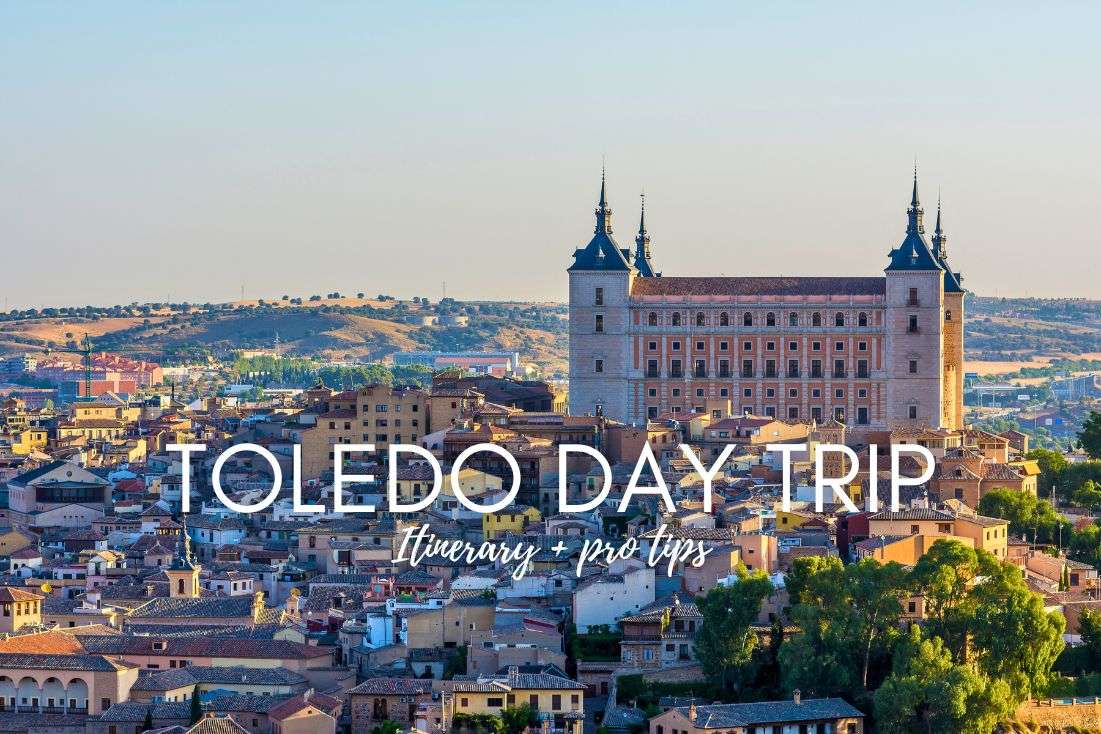
Spain really knows how to do “old city” right! Toledo’s medieval streets are straight out of a fairy tale—think Jerusalem but with more tapas bars.
Toledo’s bigger than its neighbors, just right for the perfect 1-day itinerary. Unlike some historic towns where the charm is doled out in tiny doses, Toledo’s got it in spades, everywhere you look, but you won’t be overwhelmed. With tons of great things to do, you’ll be breezing through history in no time. Speaking of the breeze: fair warning, the wind here is no joke.
One of the coolest things about Toledo are the escalators. Yep, there are outdoor escalators to whisk you up and down the steep slopes s you don’t even break a sweat. It’s like finding a spaceship in the Middle Ages.
Toledo has worn many crowns—Arab capital, heart of Castile, and home of the legendary El Cid. When Madrid stole the spotlight, Toledo hit pause, freezing its rich history in place. The Arab influence here is palpable, with architecture that’ll transport you to Granada. The best swords in history were forged here, and the city’s past is as bloody as it is fascinating. The Civil War in 1936 was a particularly dark chapter.
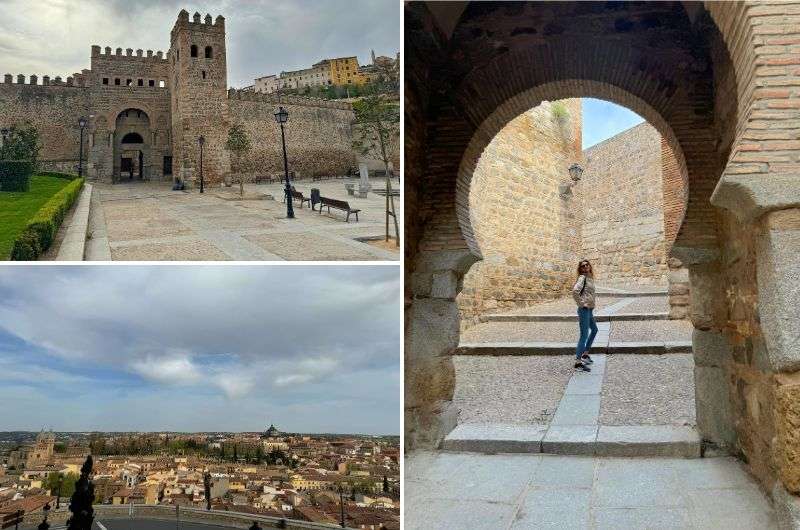
In this itinerary you will find the best things you can see and do in Toledo in a day
Stay overnight if you can; the city sheds its touristy shell and becomes pure magic when the day-trippers leave. Toledo’s one of Europe’s oldest cities, and trust me, it’s got stories to tell!
How to spend a day in Toledo + map
Get this route on Google Maps. I’ve already mapped it out for you, all you need to do is click and follow along. Hotel tip: Hotel Boutique Adolfo
I put together the perfect one-day itinerary for you, based on my own visit to Toledo Spain in spring 2024. Here’s a summary of how you can see the best of Toledo in one day:
- Stop 1: Walls and gates of Toledo Begin your trip with the mighty walls and gates that have protected Toledo for centuries.
- Stop 2: Bridge of Alcántara Next, the perfect spot for a quick photo session, capturing both the bridge that spans the Tagus River and the city’s skyline.
- Stop 3: Museo Cromática Do not miss Museo Cromático, a sensory overload of vibrant pianos and colorful guitars (among others). Very random, but we loved it here so much!
- Stop 4: Alcázar of Toledo Visit the Alcázar, a fortress housing a superb military museum (and secret views over the city).
- Stop 5: Toledo Cathedral Marvel at the Toledo Cathedral. Check out the sacristy for works by El Greco, Velázquez, and Caravaggio.
- Stop 6: Convento de los Reyes Explore the Convento de los Reyes, a serene oasis amidst the Gothic overload.
- Stop 7: Sephardic Museum Dive into the rich Jewish history of Toledo at the Sephardic Museum, set in a stunning former synagogue. It’s a refreshing change from all the cathedrals.
- Stop 8: Museo del Greco A taste of El Greco’s life and art. If you're planning a trip to Madrid's Prado Museum, you might consider skipping this one.
- Stop 9: Manchego Museum Cheese enthusiasts, rejoice! The Manchego Museum is all about Spain’s famous Manchego cheese. It’s delightful (and delicious), though it could use a bit of sprucing up.
- Stop 10: Mosque of Christ A super-quick stop in a church that’s really a mosque with a Jesus on a cross hanging inside.
- Stop 11: Mirador del Valle End your Toledo tour at the Mirador del Valle. The panoramic views of Toledo are breathtaking, even if they don’t quite rival those of Segovia.
I’ll go onto detail about each stop below, including opening times, prices, directions, and practical tips so you don’t have to do anything but find those escalators and get up there!
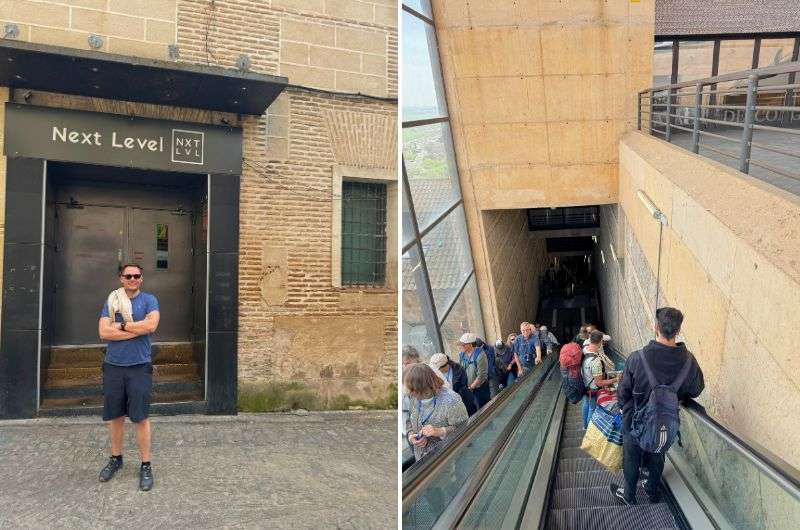
Toledo loves Next Level of Travel!
Practical tips for visiting Toledo
- Parking in Toledo Spain: The drive from Madrid takes about 1 hour depending on traffic. In Toledo, park near the city gates in the northern part of the city. There are parking lots outside and several huge underground garages dug into the rock beneath the city which make this easy… if your car is small enough to fit in narrow parking spots. Miradero Parking and Indigo Parking both charge about EUR 2 per hour or a maximum of EUR 21 per day.
- Toledo train from Madrid: From Madrid Atocha to Toledo, direct trains leave at least once an hour, the fast ones take 36 minutes, and cost EUR 14 per person. The train station in Toledo is 1.5 km (1 mi) from the city gates—a bus, taxi, or your own two feet can take you to the city center.
- Escalators: Use the nifty escalators to navigate the steep inclines in Toledo. Yes, really! There are several, like this Safont escalator which is useful if you’re coming from the train station, this escalator near the castle, and this escalator on the western side of the main gates.
- Opening hours: Opening hours at Toledo’s attractions are all over the place, so pay attention. Privately owned places usually have longer hours than state-owned sights, and many close during siesta. I’ve included all this info in the itinerary below.
- Stay overnight: Consider staying overnight to experience Toledo without the day-trip crowds. Try Hotel Boutique Adolfo close to the castle—it’s remarkable.
- Coffee: Cafés in Toledo are 50/50 in terms of quality—I literally threw away 2 out of 4 coffees I bought. The tricky part is that they often have good reviews. Look for the smaller, hipster-looking ones for the best results.
- Best tapas in Toledo: Try Taberna Skala, operating since 1860, for an authentic taste of Toledo. It’s close to the Cathedral and Alcázar, so I recommend stopping by Skala for lunch between visiting the two.
Toledo Spain itinerary: Getting in
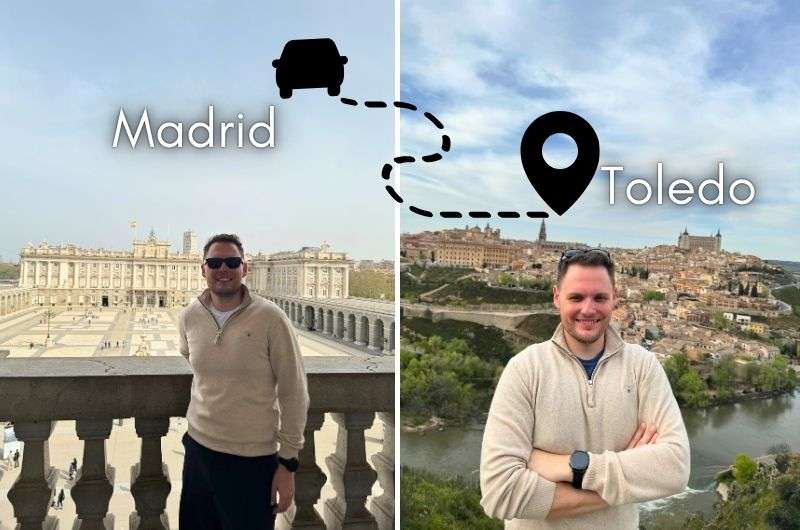
Driving takes about twice as long as taking the train from Madrid to Toledo
If you’re driving into Toledo from Madrid, park at the northern end of Toledo near Bisagra Gate, either in the parking lots (there are many) or in the underground garages. These are dug into the rock under the old town—pretty cool! The spaces are tight, so don’t rent a massive car.
If you’re coming in by train from Madrid, the train station in Toledo is about a 25-minute walk from the historical part of town. Or hop into a taxi and get there in no time. Trains leave Madrid at least once per hour and take 36 minutes from Madrid Atocha Station.
Stop 1: The walls and gates of Toledo | Free, always open
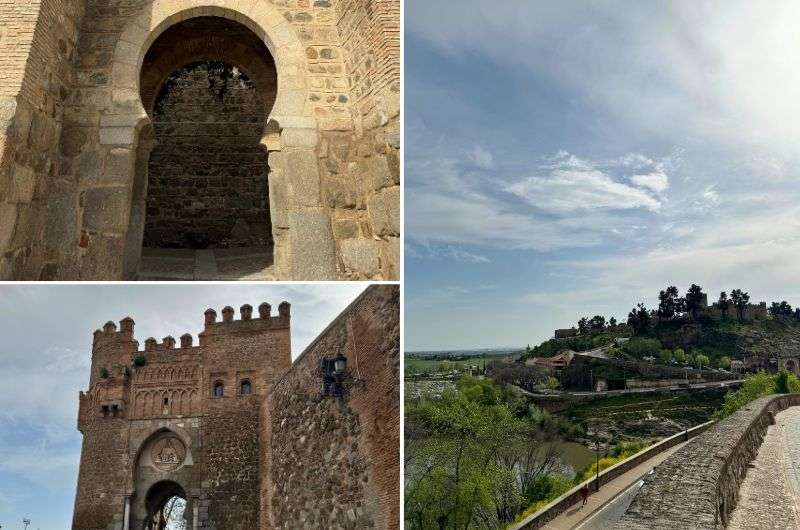
The walls and gates pretty much besiege the whole city so if you follow them, you will come across many nice spots with views
- Time spent here: 20 minutes
The walls of Toledo are a testament to the city’s long and tumultuous history. Stretching around the old town, they were originally constructed during Roman times and later fortified by the Visigoths and Moors. You can follow the walls for a scenic route at any time during your day in Toledo, as there are numerous spots with towers that offer fantastic views of the city and the Tagus River.
Thinking out loud: Btw, how come Spain has all these spectacular walled cities and other European countries don’t?
Anyway, your Toledo itinerary kicks off at the main gate to the city, Puerta de Bisagra, a massive and imposing structure originally built by the Moors in the 10th century. The current gate, with its majestic twin towers and Imperial coat of arms, dates back to the 16th century and is a blend of Moorish and Renaissance architectural styles.
You’ll need to stand back to fit the whole thing in your photos, and you’ll want to get there early to have a shot at getting a pic without the crowds of day trippers.
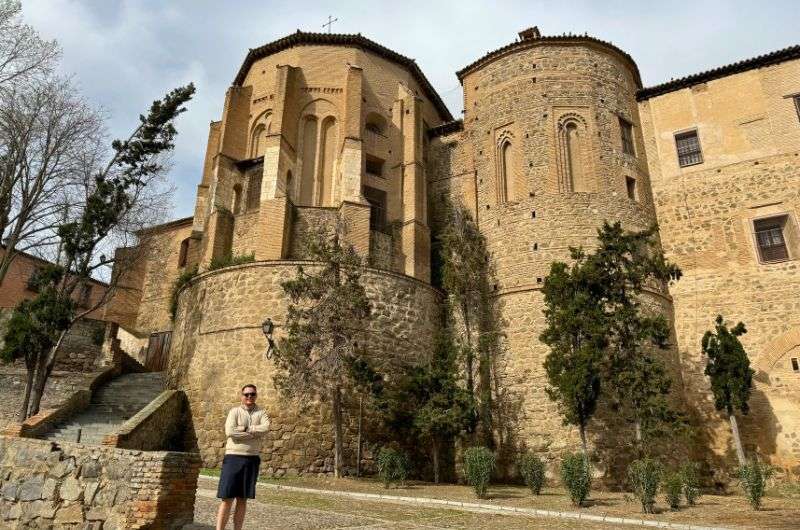
Prepare to have your photo taken at many of the stops, as some of the gates look truly majestic
Fun fact: The name “Bisagra” comes from the Arabic word “Bab-Shagra,” meaning “Gate of the Sacred”.
Next, make your way to Puerta del Sol, another iconic gate that dates back to the late 14th century. This gate is named for the sun and moon symbols that adorn it and is a beautiful example of Mudéjar architecture, blending Christian and Islamic design elements. Puerta del Sol was part of the second layer of walls that fortified the city, demonstrating the strategic military importance of Toledo.
And then, keep walking along the outside of this second layer of walls… until you leave the city altogether. Tour’s done, did you love it?! Just kidding. But you need to make a quick stop at this next spot…
Stop 2: Alcantara Bridge and viewpoint | Free, always open
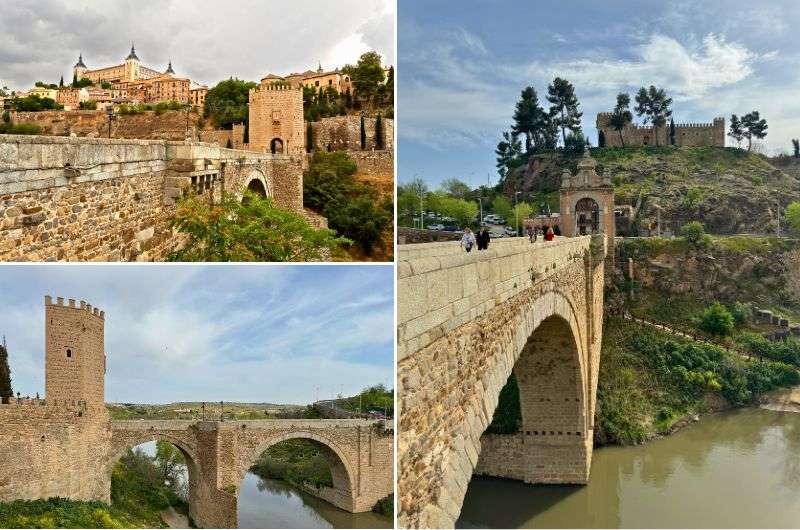
Alcántara Bridge
- Distance from last stop: 650 m (0.4 mi), a 10-minute walk
- Time spent here: 15 minutes
…because it’s time to head over to the legendary Bridge of Alcántara. This spot is a photographer's dream and an absolute must-see… for about 10 minutes. Built way back in the 2nd century AD, it has been the main crossing over the Tagus River for ages. With its sturdy stone arches and commanding presence, you can almost hear the echoes of Roman soldiers marching across.
Fun fact: The name “Alcántara” comes from the Arabic “Al-Qanṭarah,” meaning “the bridge.” How original!
I agree with the Arabs, it’s just a bridge, so keep moving. It’s not like there’s that much to do here. That said, take some extra time to walk to the other side of the river and then to the walkways that are perfectly positioned for those epic shots. When you get the Alcántara Bridge and Toledo’s Old Town in one picture, the heavens open up and the travel gods applaud you. Google Maps says the walkway area and viewpoint is called Mirador Rio Tajo, so check it out and head there before moving on to your next stop.
Stop 3: Museo Cromática | Entry fee EUR 8, Open daily except Tuesdays 11 am–8 pm
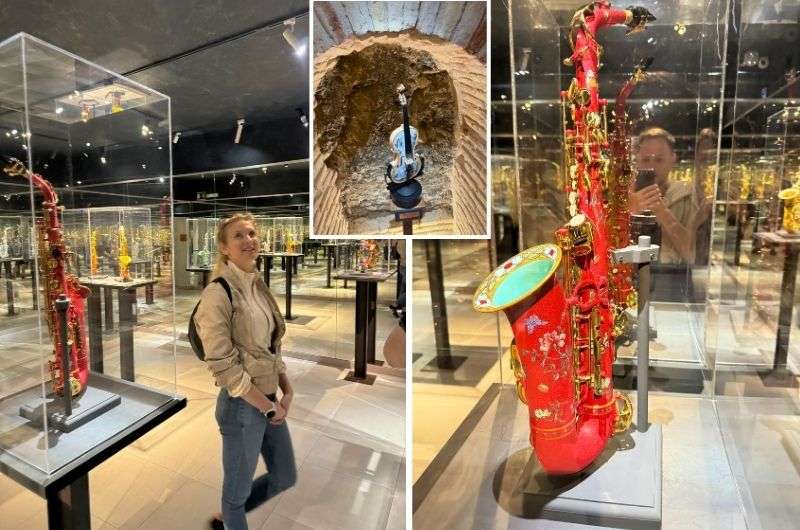
We came across the Museo Cromática by chance, and we were mesmerized!
- Distance from last stop: 350 m (0.2 mi), an 8-minute uphill walk
- Time spent here: 1 hour
- Price: EUR 8 including welcome drink. Tickets are valid all day, including during concerts.
- Opening hours: Daily except Tuesdays 11 am–8 pm
- Website: Cromática Museum
Alright, now it’s time to start exploring Toledo’s Old Town. That means you need to put your walking legs on, because it’s all uphill from here.
If there’s one unexpected gem in Toledo that you absolutely cannot miss, it’s the Museo Cromática. I know what you’re thinking—”A musical instrument museum, Jan, really?” Yes, really. This place was an absolute highlight of my trip—and it wasn’t even on my original list! Lucky for you, I’m sharing this golden nugget of travel wisdom so you don’t have to rely on serendipity like me.
Museo Cromática is a museum meets art gallery—all the instruments are covered in works of art! It’s like Salvador Dalí decided to redecorate a music store, with vibrant pianos, colorful guitars, and psychedelic musical instruments everywhere you look. It’s quirky, it’s cool, and it’s completely unforgettable. Every corner has something better than the last, so give yourself time to discover it all. For a budding musician like me, it was like I’ve found my people! The live music playing all day adds to the vibe.
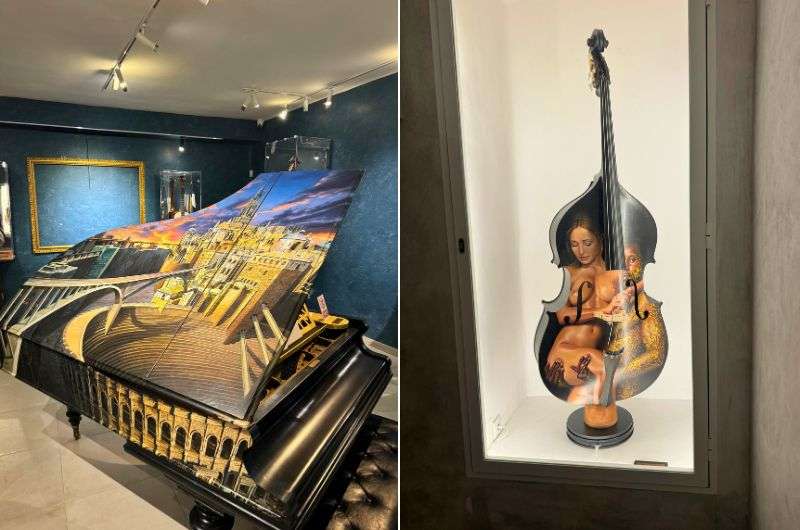
It's just musical instruments, only much more visually interesting. My piano does NOT look like this!
Even if you’re not musically inclined, you’ll appreciate the creativity and the sheer fun of this place. I suspect it would be a great place for kids to learn about music, too, with the interactive exhibits.
Souvenir tip: If you’re feeling particularly flush, you can actually buy some of these unique instruments. Prices range from EUR 4,000 to a jaw-dropping EUR 1.5 million! I decided to stick to my bland piano for now.
Your EUR 8 ticket includes a welcome drink and is valid all day. This means you can pop back in for one of their concerts if you get hooked.
Stop 4: Alcázar of Toledo (fortress) | Entry fee EUR 5, free on Sundays, open daily except Mondays 10 am–5 pm
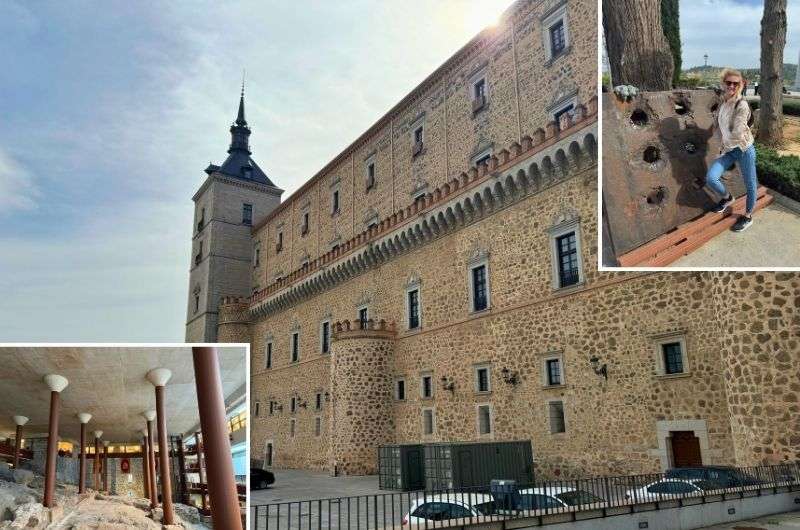
The Alcázar de Toledo is a top spot your Toledo itinerary
- Distance from last stop: 200 m (0.1 mi), a 3-minute walk
- Time spent here: 2 hours
- Price: EUR 5 + EUR 3 for audio guide, free on Sundays
- Opening hours: Daily except Mondays 10 am–5 pm. Closed Mondays
- Website: Alcazar de Toledo
No day trip to Toledo is complete without exploring the cities fortress, the Alcázar de Toledo. It’s only a short walk from the Cromática Museum to the Alcázar, a symbol of the city.
Fun fact: The Alcázar played a crucial role during the Spanish Civil War in 1936, withstanding a 70-day siege. Its resilience turned it into a symbol of Spanish nationalism (fascism).
Finding the entrance
The tricky part is finding the entrance to Alcazár. As you walk towards the Alcázar, you look for a castle-y looking gate. When you look at Google Maps, it looks like you’re supposed to enter from the south side. But no, you go in through the modern-looking northern entrance of the Museo del Ejército (Army Museum). That’ll take you inside into the castle-y looking inside area that you’d expect.
Buy your tickets and make sure to get the audio guide too—it’s extra, but it’s totally worth the knowledge boost!
What’s inside
The Alcázar of Toledo is a symbol of Toledo’s resilience and strategic importance. Originally a Roman palace, it was later fortified by the Moors and then rebuilt by the Spanish in the 16th century. Today, it houses a fantastic military museum that showcases Toledo’s storied past. And I’m a sucker for anything involving the history of weapons and armies! The Army Museum is top-notch and extensive, and you will at least learn a lot of interesting things, if not fall in love like I did.
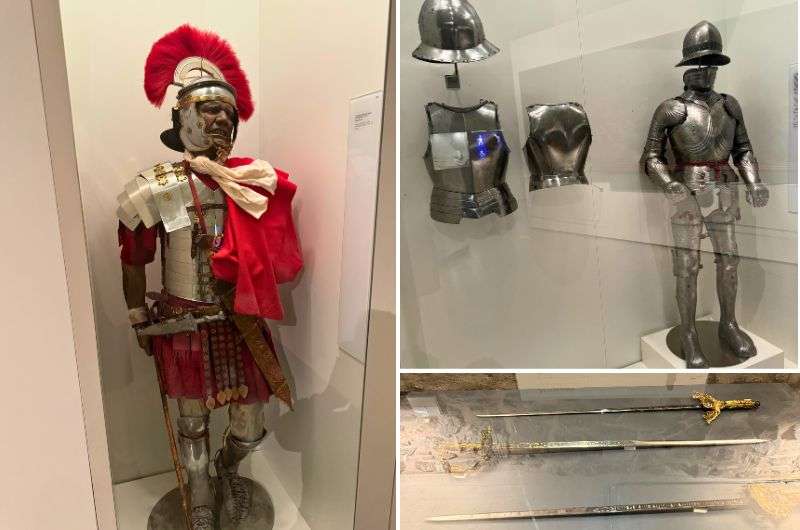
Inside you will find historical weapons, armor worn by distraught figurines, and other artefacts
Don’t miss the displays of Toledo steel, which was unfortunately closed when we visited. I liked that they don’t sugarcoat medieval battles. They’re shown as realistically brutal, not some romanticized melee. And the Visigoths, the founders of Gothic architecture, get their due here, which is a rarity in Europe. What can I say, I was in my happy place!
It's really interesting how they only present fun facts and make an effort to cater to kids and those less knowledgeable about history. It’s pretty interactive too, which keeps things interesting. It took us about 2 hours to get through all the exhibits. One thing that made me “wow!”? Iron plates with 20 cm-thick holes blasted through by artillery.
Besides the military museum, there are also the remains of the aqueduct, and the top floor is dedicated to important moments in history of the the Alcázar itself. But wait!...
Secret viewpoint
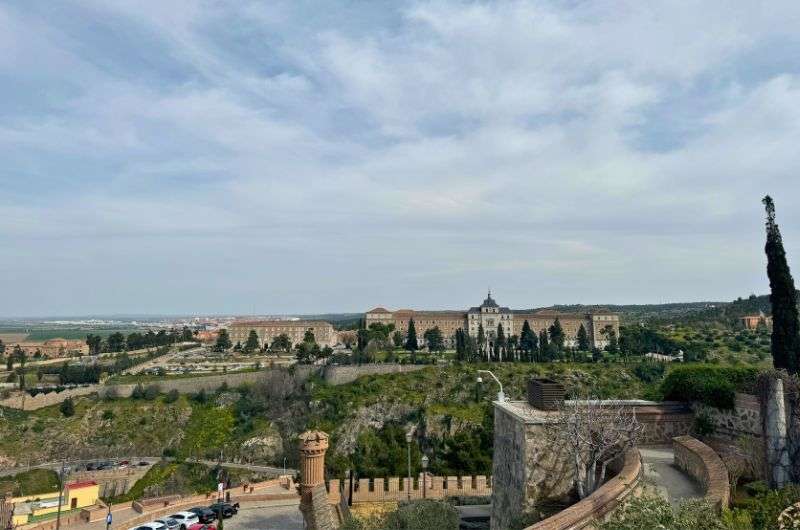
And, of course, we can't forget to mention the beautiful view from the Alcazar
When you’re done with the Army Museum at the Alcázar, walk outside and around the corner to the other side of the fortress. There, through the public library, you can go in for free. Head to the terrace on the 5th floor. It gives you an excellent view of Toledo!
Stop 5: Toledo Cathedral | Entry fee EUR 12, Open Monday to Saturday 10 am–6:30 pm, Sundays 2 pm–6:30 pm
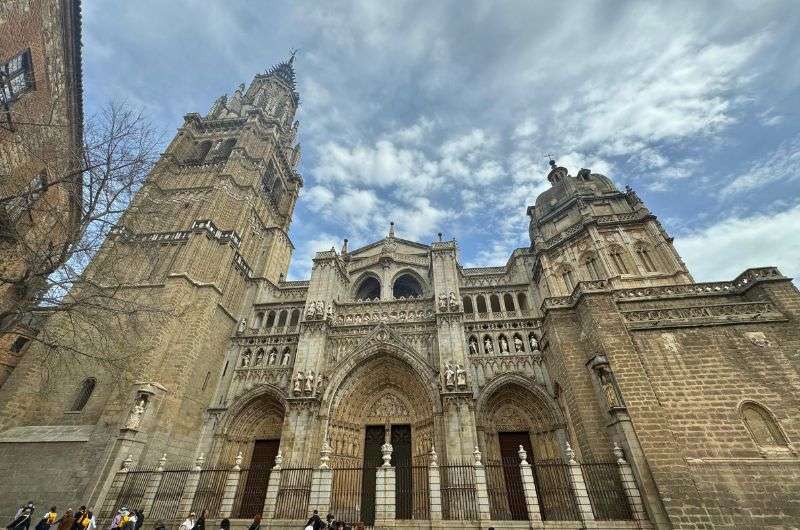
The giant Toledo Cathedral
- Distance from last stop: 350 m (0.2 mi), an 5-minute walk
- Time spent here: 30 minutes
- Price: EUR 12
- Opening hours: Monday to Saturday 10 am–6:30 pm, Sundays 2 pm–6:30 pm
- Website: Catedral Primada Toledo
Next up is the Toledo Cathedral. Now, don’t get me wrong—it’s an impressive Gothic giant, but in a city (and region!) bursting at the seams with amazing churches, it didn’t quite blow my socks off. That said, it’s still a must-see on your Toledo itinerary. Just maybe don’t look at too many churches before you get to this one so it gets a fair assessment.
There’s no audio guide, so after you pay the EUR 12 entrance fee, it’s all about wandering and discovering on your own.
What it’s like
Known officially as the Primatial Cathedral of Saint Mary of Toledo, this place is a Gothic masterpiece that took over two centuries to complete. It’s huge, it’s intricate, and it’s packed with history and art. I thought some of it was pretty brutal; get ready to see saints getting beheaded! Do churches get a PG rating??
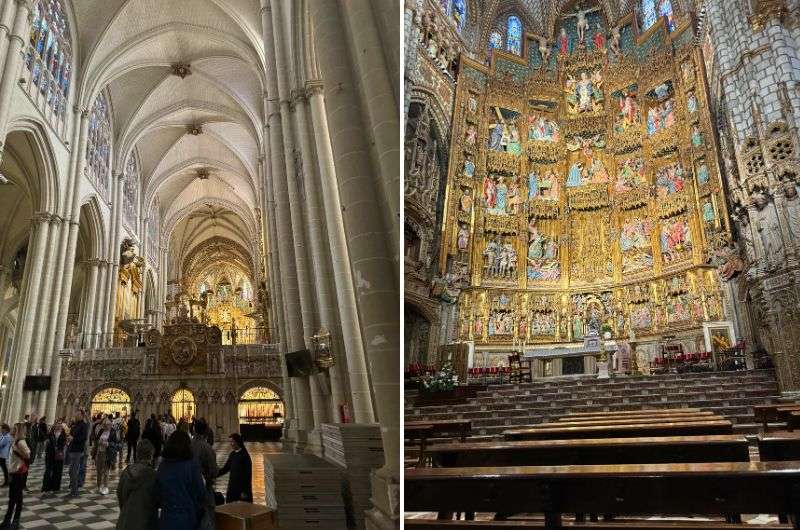
Rich Gothic decoration can be seen throughout the vast interior of Toledo Cathedral
The cathedral has that aged, brick-heavy look that makes it seem even older than it is. It’s a little hard to see the whole cathedral from afar, but step inside, and it's huge! It’s got 5 naves, soaring arches, and an elaborate façade that’s pretty stunning, and don’t forget to look up at the ceiling, too.
Fun fact: Toledo’s Cathedral stands on the site of a former mosque, which itself was built over a Visigoth church. The five-nave design was intentionally planned to cover the sacred space of the former mosque, with the cathedral and its cloister covering the former mosque’s courtyard.
Art inside Toledo’s cathedral
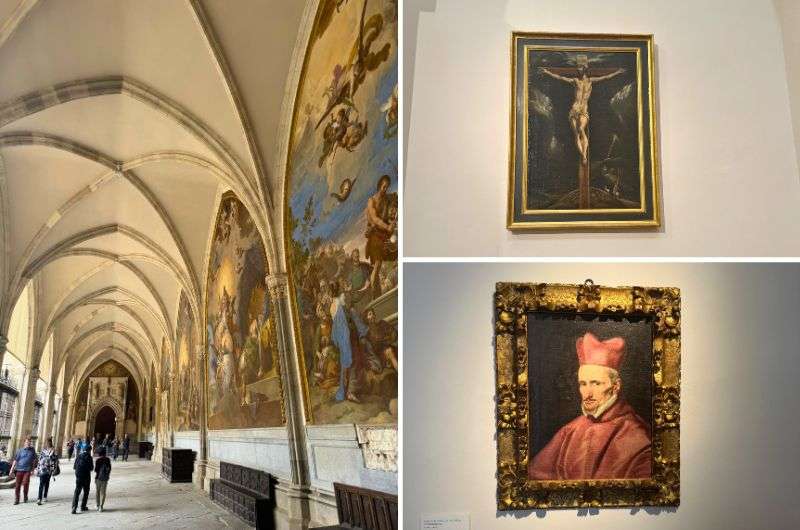
Toledo Cathedral is home to many works of art by famous painters
But it’s not just the architecture you can admire at Toledo’s Cathedral. The cathedral is home to works by big names like El Greco, Goya, and Caravaggio—it’s a mini art museum. What to look out for:
- The sacristy: Packed with paintings, including El Greco’s “The Disrobing of Christ”
- The choir: The carvings here are next-level, depicting scenes from the Reconquista
- The high altar: Gilded carvings and biblical scenes that are pretty jaw-dropping
- The treasury: Sparkling with religious artifacts, including the famous Monstrance of Arfe
Now, let’s head to our next stop: the Convento de los Reyes for a little more Gothis overload, but with less crowds.
Stop 6: Monasterio de San Juan de los Reyes | Entry fee EUR 4, Daily 10 am–6:45 pm
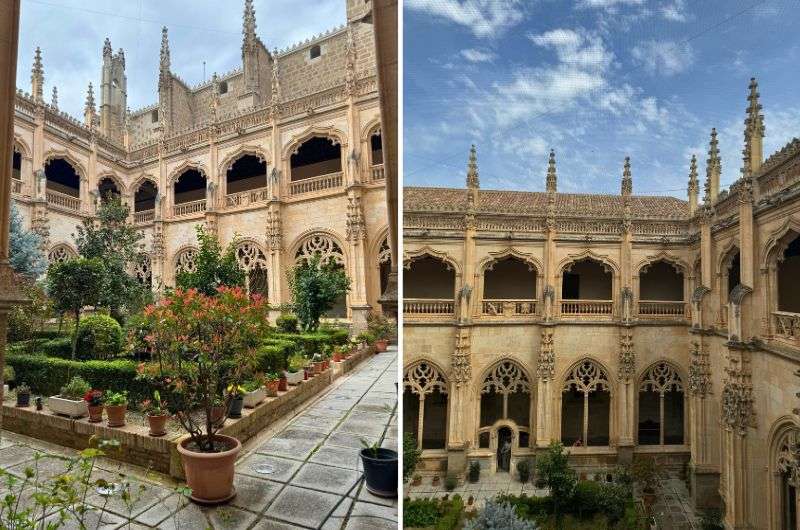
Monasterio de San Juan de los Reyes
- Distance from last stop: 900 m (0.6 mi), an 15-minute walk
- Time spent here: 30 minutes
- Price: EUR 4
- Opening hours: Daily 10 am–6:45 pm
- Website: Monasterio de San Juan de los Reyes
Having spent all of your day so far in the eastern part of town, it’s time to go check out what’s happening in the west. The good thing about leaving all the main tourist attractions behind is that you’re also leaving the majority of the day trippers behind, a major score in my book. This next stop is going to be a welcome peaceful respite.
What to expect inside the monastery
This monastery, built in the Isabelline Gothic style, is a mix of Gothic and Mudéjar elements. I think the combination of both is seriously cool and quite unique. (Have I mentioned the lack of crowds?)
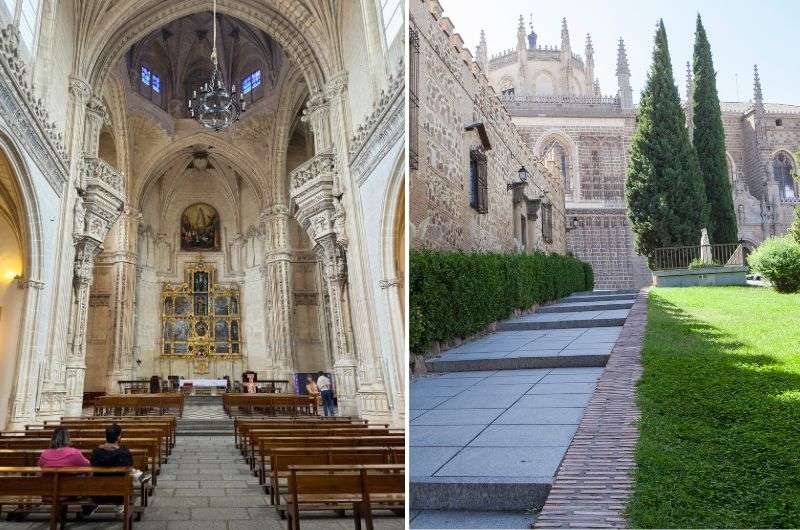
The Monasterio de San Juan de los Reyes will only take you half an hour of quiet walking and contemplation as the monks used to do here
It was founded by the Catholic Monarchs, Ferdinand and Isabella, to celebrate their victory at the Battle of Toro in 1476. They originally intended it to be their final resting place, though they were eventually buried in Granada. I can relate—it’s like that time I spent all this energy choosing my new sofa and then when I finally set it up in my living room, I was like ‘meh’ and had to start the process all over again.
Fun Fact: The cloister garden was specifically designed to help monks cope with Toledo’s scorching summer heat.
You only need 30 minutes max to see the monastery, and I sense that you’re ready for something different right about now. Happy to oblige!
Stop 7: Sephardic Museum and Synagogue | Entry fee EUR 3, free on weekends, open Tuesday to Saturday 9:30 am–8 pm, Sundays 10 am–3 pm
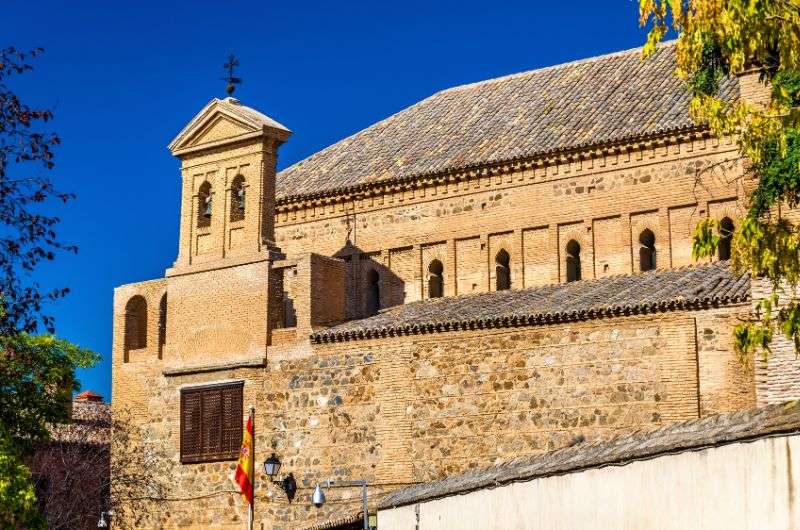
Synagogue of El Tránsito
- Distance from last stop: 350 m (0.2 mi), a 5-minute walk
- Time spent here: 45 minutes
- Price: EUR 3. Free on Saturdays after 2 pm and Sundays
- Opening hours: Tuesday to Saturday 9:30 am–8 pm, Sundays 10 am–3 pm, Mondays closed
- Website: Sephardic Museum and synagogue
Time to dive into a different slice of Toledo’s history at the Sephardic Museum, housed in the beautiful Synagogue of El Tránsito. If you’re ready for a break from the Gothic and Christian overload, this spot offers a fascinating glimpse into the Jewish heritage of the city.
What to expect
The Sephardic Museum is all about the history, culture, and legacy of the Sephardic Jews, who lived in Spain until their expulsion in 1492. It’s a real treat for anyone interested in history or architecture or Jewish culture. It’s packed with artifacts, from religious texts to clothing and cultural items.
Check out the garden with recovered Jewish tombstones. Did you know some of these stones were recycled as building materials? Not cool, people, not cool.
Granted, I think it could use some elevating (or budget?) to turn it into a truly top-notch museum, but there’s not exactly huge competition on the topic, so you’ll have to make do with what you get.
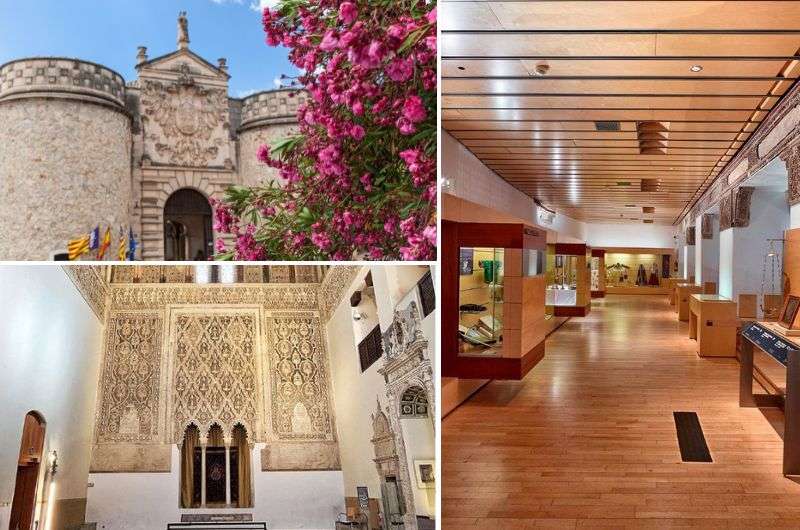
Fun fact: The women’s gallery in the synagogue offers a peek into the lives of Sephardic women. It's like getting the behind-the-scenes tour of a centuries-old soap opera.
But wow, those details on the walls and ceiling of the synagogue! That’s something anyone can admire, even if you’re about as knowledgeable about architecture or Judaism as a goldfish is about mountain climbing. The stucco work and wooden ceilings reflect the blend of Jewish and Islamic art, a hallmark of Sephardic architectural style.
Who are Sephardic Jews?
The term "Sephardic" comes from the Hebrew word "Sepharad," which is a biblical location that scholars have historically identified with the Iberian Peninsula—modern-day Spain and Portugal. Sephardic Jews are descendants of the Jewish communities that lived in these regions before their expulsion in 1492 by Ferdinand and Isabella.
On the other hand, Ashkenazi Jews originated from Central and Eastern Europe, including Germany, Poland, Russia, and Lithuania.
Sephardic Jews developed their own language called Ladino, also known as Judeo-Spanish. It’s a mix of medieval Spanish, Hebrew, and bits of Turkish, Greek, and Arabic… kind of like Spanglish, Jewish edition.
After their expulsion, they spread to North Africa, the Ottoman Empire (including present-day Turkey, Greece, and the Balkans), and parts of Western Europe.
Sephardic culture is rich with proverbs that reflect their wisdom and humor. One example is, "A quien Dios ama, le da casa en Toledo" – "To whom God loves, He gives a house in Toledo." Basically, if you’ve got a house in Toledo, you’re winning at life.
Stop 8: El Greco Museum | Entry fee EUR 3, free on weekends, open Tuesday to Saturday 9:30 am–7:30 pm, Sundays 10 am–3 pm
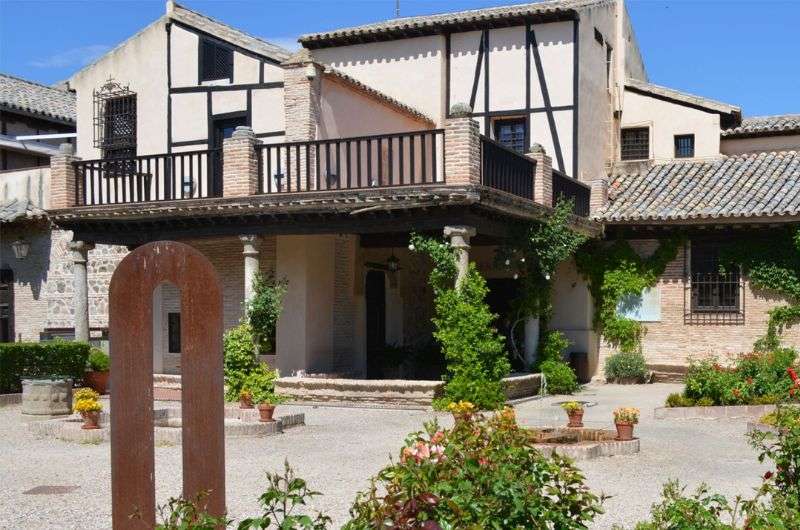
- Distance from last stop: Right next door, a 1-minute walk
- Time spent here: 30 minutes
- Price: EUR 3, free on Sundays and Saturdays after 2 pm
- Opening hours: Tuesday to Saturday 9:30 am–7:30 pm, Sundays 10 am–3 pm, closed Mondays
- Website: Museo del Greco
Alright, art lovers, this one’s for you! Unless you’re such a big art lover that you’re heading to the Prado in Madrid (one of the top museums in all of Spain!). In that case, or if you’ve found it’s impossible to see everything in Toledo in one day, you could skip Toledo’s little El Greco Museum and just wait for the big guns in Madrid.
The Museo del Greco is a charming house right next door to the Sephardic Museum dedicated to—who would’ve guessed?—the life and works of the iconic painter El Greco. The house wasn’t in fact his, but it’s recreated to look like it was, so you can imagine what it was like to be the guy that painted everything elongated and with weird colors.
Fun Facts: El Greco’s real name was Domenikos Theotokopoulos. He got the nickname "El Greco", meaning “the Greek”, because let’s face it, his name is a mouthful. He was born in Crete. El Greco’s style was so different that he puzzled the public and scholars until the 20th century, when he finally found appreciation. I hope he enjoyed his fame from the afterlife.
What to see inside the museum
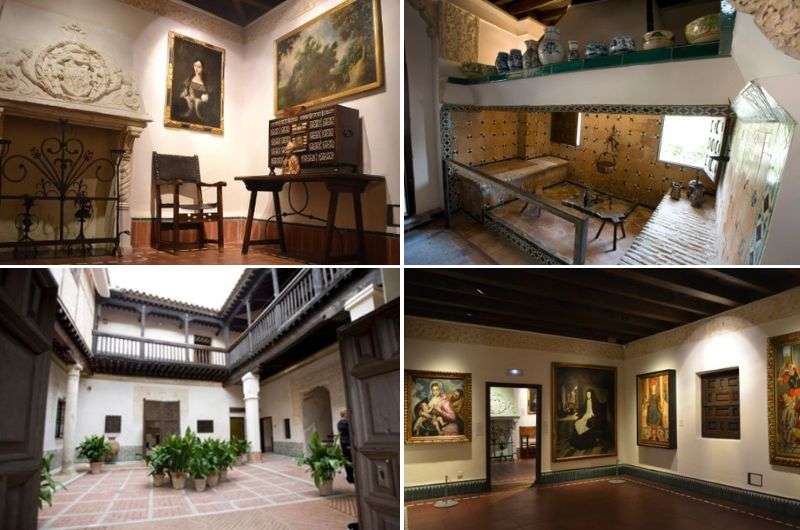
Here's a taste of what you can find at the Museo Greco. These and other photos can be found on their official website – Museo Greco
- Main room: Dedicated to El Greco’s saint paintings, which are some of his most famous works. Check out the intense colors and dramatic expressions that make his style so unique. Either that or everyone he painted didn’t actually want to sit for the portrait.
- The house and cellars: Furnished to recreate the atmosphere of the time, giving you a feel of how El Greco might have lived and worked.
- The garden: A small but beautiful garden that offers a peaceful spot to sit and reflect on the art you’ve seen. Or maybe wonder who decides which art is note-worthy.
The Museo del Greco is the only museum in Spain dedicated solely to this iconic painter, making it a must-visit for art enthusiasts and anyone that likes to feed their soul with knowledge. It’s a nice tribute to El Greco’s legacy, nestled in the heart of Toledo in the Jewish quarter.
Stop 9: Manchego Museum | Free entry, EUR 7 for tasting, open Wednesday to Friday 10:30 am–7 pm, Saturdays 11 am–9 pm, Sundays 11 am–8 pm

- Distance from last stop: 800 m (0.5 miles), a 10-minute walk
- Time spent here: 45 minutes
- Price: Free entry, EUR 7 for tastings
- Opening hours: Closed Monday and Tuesday, Wednesday to Friday 10:30 am–7 pm, Saturdays 11 am–9 pm, Sundays 11 am–8 pm, tastings end 1 hour before closing time
- Website: Museo del Queso Manchego
The Manchego Museum might sound a bit cheesy (pun intended), but if you’re a fan of this iconic Spanish cheese (or cheese in general), it’s a stop you won’t want to miss.
Full disclosure: The manchego museum isn’t going blow your mind with high-tech exhibits. But as your itinerary for 1 day in Toledo nears its end, it’s the perfect time for some edible souvenirs! So why not.
If you’re expecting something incredible like the beer or chocolate museums in Belgium, this ain’t it. But hey, there’s still cheese (paired with wine). The museum has signs in English, so you won’t miss a thing. I learned that the name manchego comes from the region the cheese comes from, La Mancha, which means “without water” in Arabic. The harsh, waterless conditions in La Mancha mean the sheep there graze on tough plants, which is why the cheese tastes so amazing.
The cheese tasting is the obvious highlight of the visit. You get to taste different ages of Manchego, from the mild and creamy to the sharp and nutty. Paired with local wines, it’s a match made in heaven. Don’t forget to buy a chunk of your favorite Manchego to take home. Or to the hotel—midnight snack, anyone?
Stop 10: Mosque of Christ | Entry fee EUR 4, open daily 10 am–6:45 pm
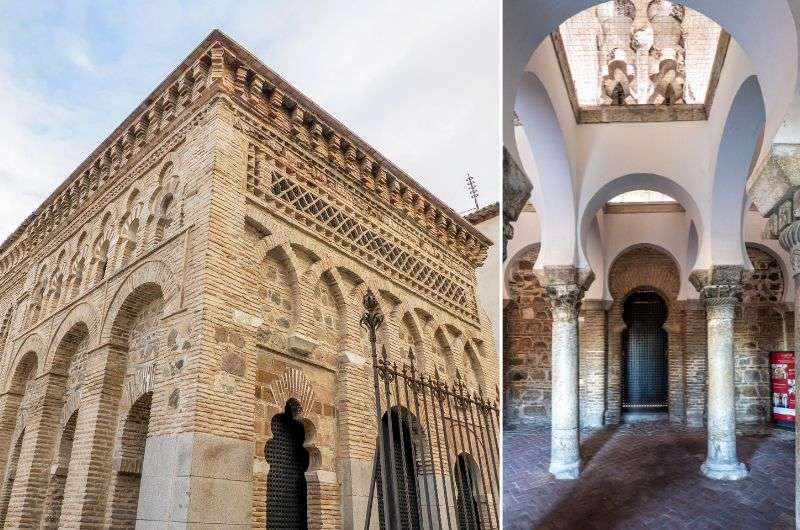
Mezquita del Cristo de la Luz
- Distance from last stop: 600 m (0.4 miles), a 10-minute walk
- Time spent here: 5 minutes
- Price: EUR 4
- Opening hours: Daily 10 am–6:45 pm
You will be wrapping up your day in Toledo pretty soon, but if you’ve got time, take a peek inside Mezquita del Cristo de la Luz—the Mosque of Christ. Yeah, you read that right. Beware of the 6:45 pm closing time, but it’s close to the main gates of Toledo, so you’ll be passing by it on your way out of the city anyway. This area was once known as the Medina, where wealthy Muslims lived.
The Mosque of Christ is the last physical statement of Muslim Toledo, albeit one with a Christian makeover. Built in 999 CE, it’s a fascinating mix of Islamic and Christian elements. It’s small and doesn’t take long to see. The fun part is seeing how they slapped a Jesus into the mosque and called it a day. There’s also a nice view of Toledo and the river from the church. I mean mosque… I mean…
It’s one of the ten mosques that existed in Toledo during the Moorish period. I’ve seen plenty of these mosque-to-church conversions in Andalusia, like the Mezquita-Catedral in Córdoba and the Giralda in Sevilla. This one in Toledo looks like it took the least effort.
Now, bid your Toledo day trip farewell with some views at the Mirador del Valle!
Stop 11: Mirador del Valle | Free, always open

Me, winning the “best Toledo viewpoint shot” championship
- Distance from last stop: a 2.5 km (1.6 mi) drive
- Time spent here: As long as your photo shoot takes
What better way to end your 1 day in Toledo than with a photo challenge! I’m only sort of kidding. This is THE place to snap that perfect shot of the city. If El Greco were alive, he’d probably be up here with an easel, furiously painting away, making the Alcázar look taller and leaner than it really is.
Now, I’ve seen a lot of viewpoints in my travels, and while this one is fantastic, I’d say it’s not quite as jaw-dropping as some of the viewpoints in Segovia. Still, it’s a must-visit, especially if you’re in Toledo with your own (rental) car; it’s easy peasy to get to.
At first, I thought this viewpoint would be too close to town to get that perfect shot, but nope, it’s just right. Perched along a scenic road, you can see the entire layout of Toledo, from the Alcázar towering over the city to the meandering Tagus River that hugs it from 3 sides. It’s the perfect ending to a day well spent exploring this incredible city.
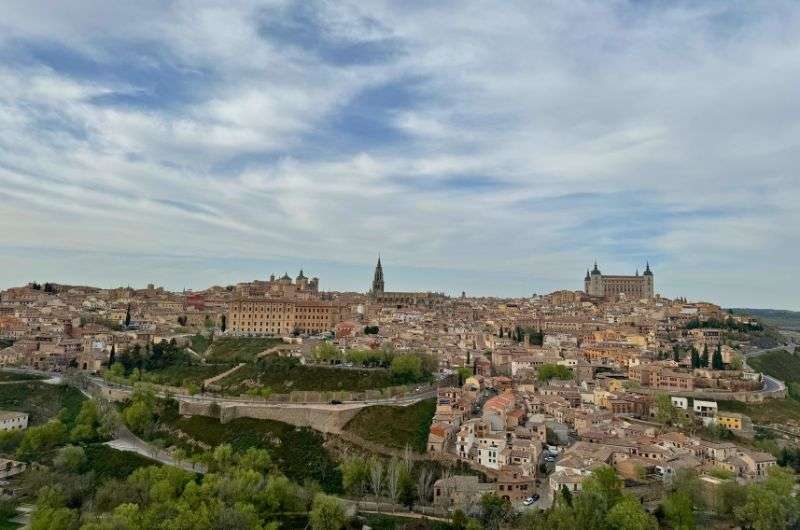
Toledo like from a postcard (but it's my photo)
After you get your best shot, it’s time to make the 1-hour drive back to Madrid. Although, this doesn’t necessarily need to be a day trip to Toledo. If you want to turn it into an overnighter, book a room at Hotel Boutique Adolfo. It could not be in a better location.
Before you travel to Toledo Spain, here are some extra FAQs that will help with your planning:
FAQ 1: How do I get to Toledo from Madrid?
Hop on a quick train ride from Madrid’s Atocha Station, and you’ll be in Toledo in a little over 30 minutes. Alternatively, you can drive on the highway—it’s a smooth ride with decent parking in underground parking lots for a few euros a day. Toledo isn’t an expensive city, and those parking options are a big plus.
FAQ 2: Is Toledo worth visiting?
Absolutely, Toledo Spain is a must-visit! But I asked myself the same question while traveling in Castile and León, not sure how good it really is, and I was thrilled I made the trip. Toledo offers stunning city views, rich history, and an Andalusian vibe with its Islamic legacy. Compared to nearby Avila and Segovia, Toledo excels in its museums and overall vibe.
FAQ 3: How many days do I need for Toledo?
One day in Toledo (Spain) is enough, but you could stretch it to two if you’re into leisurely strolling or a serious history buff. I zipped through the main attractions in 7-8 hours, but if you enjoy soaking in the atmosphere or exploring every nook and cranny, two days might be better. Alternatively, Toledo makes a great base for sightseeing around Castile-La Mancha and Madrid (which I think isn’t worth more than 2 days tops).
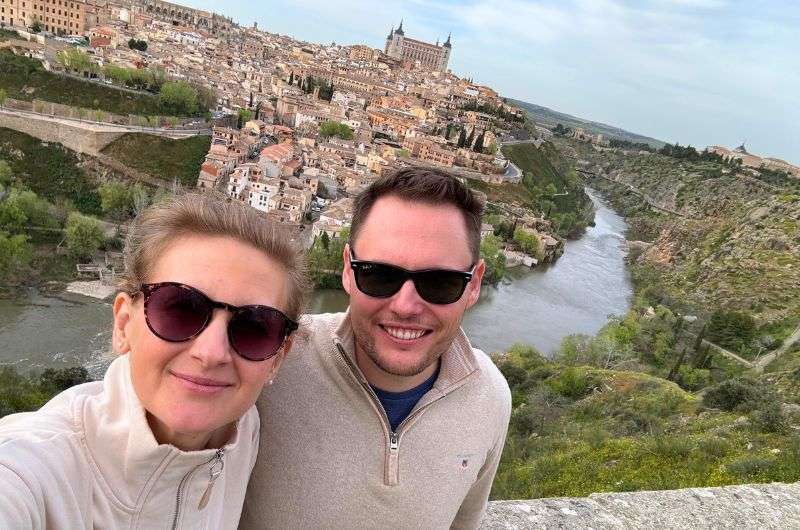
We made it in one day, and I'm sure you will too
FAQ 4: Is Toledo a walkable city?
Yes, Toledo is very walkable. The city is compact, and most attractions are within walking distance. Just be prepared for some hills and cobblestone streets. But hey, they’ve even got escalators to help you out with the steep parts!
FAQ 5: Is Toledo walkable from the train station?
You can walk from the train station to Toledo’s Old Town, but it’s a bit of a hike, though escalators will help you out in the final stretch. The train station is about a 20-minute walk from the city center. It’s a scenic route, but if you’re not up for the trek, taxis and buses are readily available.
FAQ 6: Why is Toledo so famous?
Toledo is famous for its rich history, stunning architecture, and cultural blend. Known as the "City of Three Cultures," it has significant Christian, Jewish, and Islamic influences. Plus, it’s the home of the legendary painter El Greco and the famous Toledo steel. You may leave convinced you need a sword.
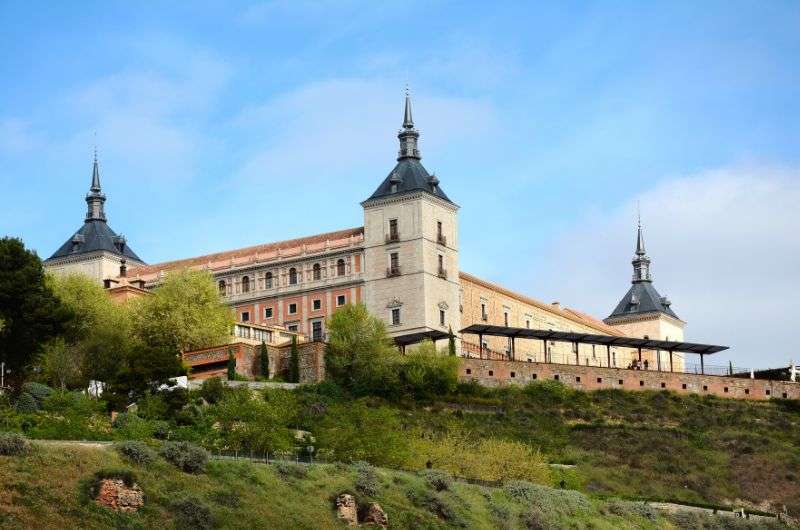
Like Segovia, Toledo has its own Alcázar
FAQ 7: Is Toledo a beautiful city?
With its medieval streets, stunning cathedrals, ancient synagogues, and picturesque views over the Tagus River, Toledo is a visual treat.
FAQ 8: Is the Toledo Alcázar free?
The entrance fee for the Alcázar is EUR 5, and it’s an extra EUR 3 for the audio guide. But here’s a tip: it’s free on Sundays, so plan accordingly if you’re on a budget.
Feel free to drop by the comments section if you have more questions or need tips for your trip to Toledo!
You might also be interested in reading:
- 10-Day Spain Itinerary
- 10 Best Places to See in Mallorca
- 5 days in Barcelona (with day trips)
- How to Visit the Alhambra in Granada
- Andalusia Itinerary: Southern Spain in 10 Days
This post contains affiliate links. I earn a small commission if you make bookings through my links, at no additional cost to you. Thank you for your support!


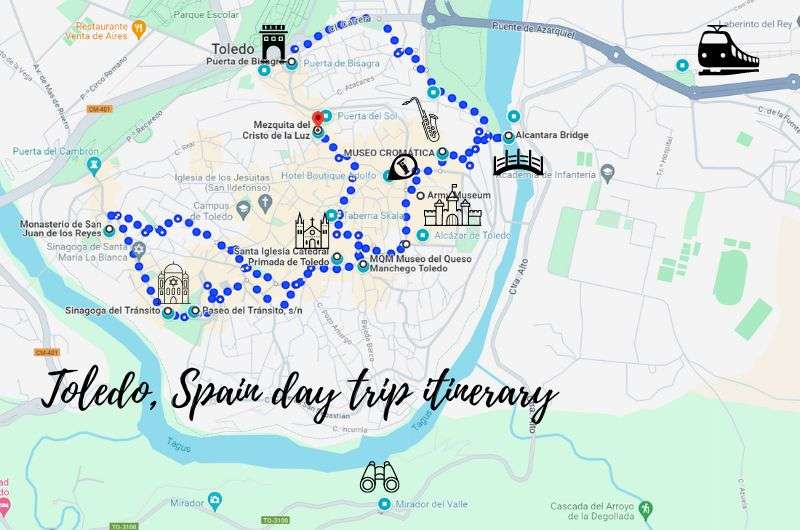
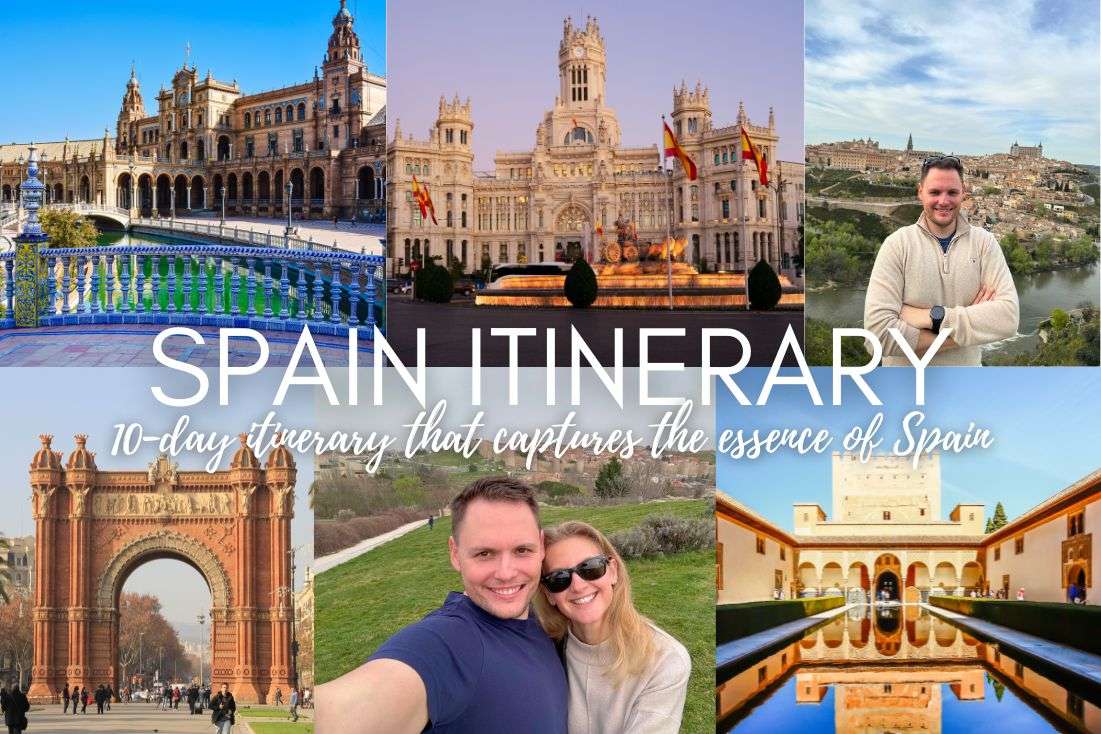
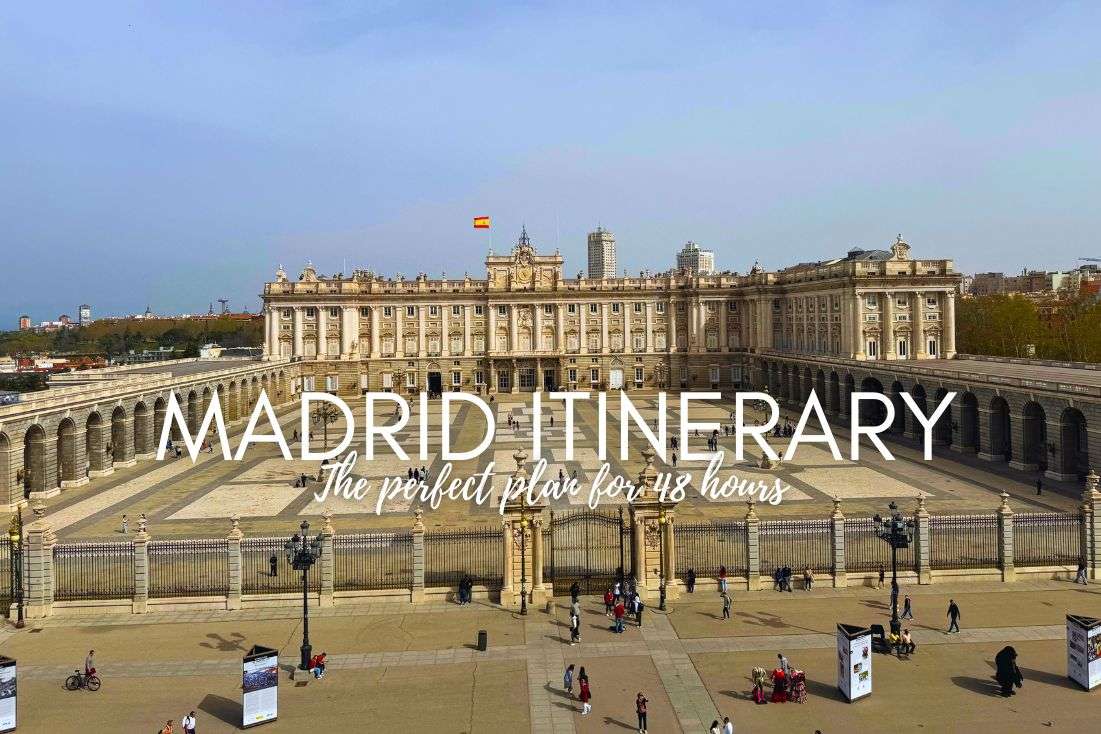
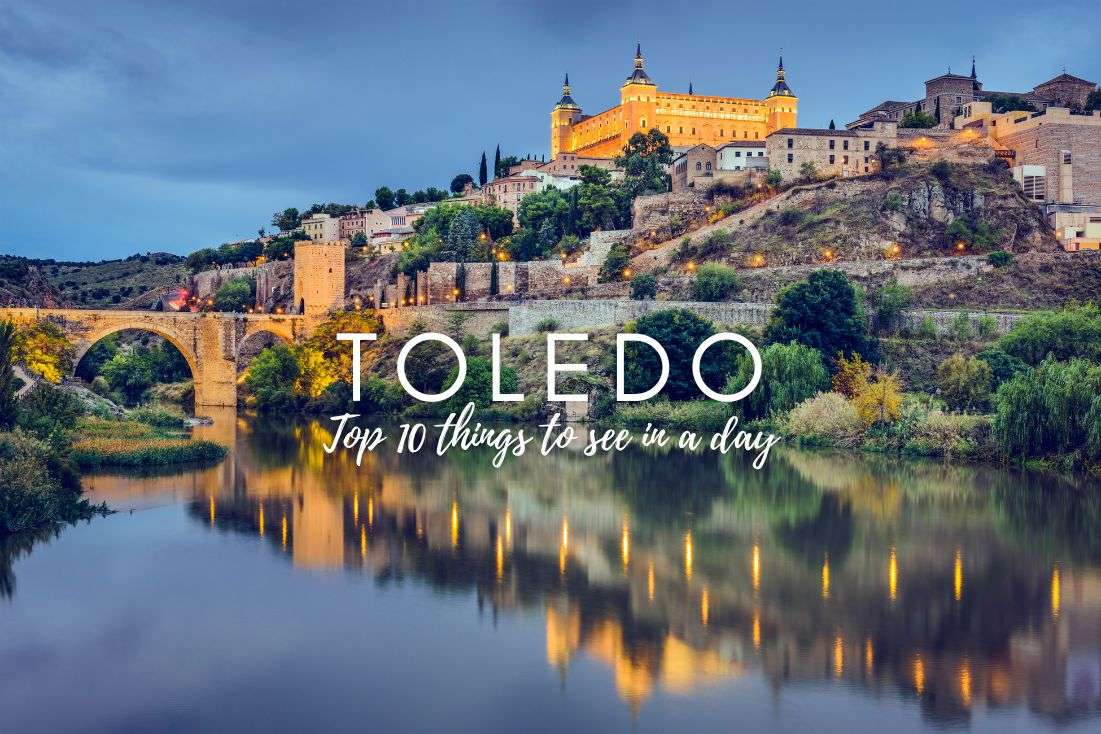





Comments | Thoughts? Give us a shout!